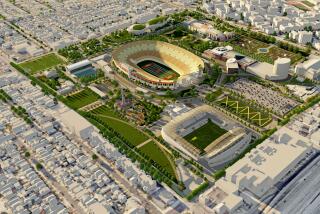On Emerald Pond
- Share via
In less self-conscious times, Los Angeles was the epicenter of American exoticism.
And if the spirit of uninhibited fantasy that gave rise to apartments that resemble Moorish villas, shaped restaurants like hats and combined crocodile farms with beer gardens has a surviving visual symbol, it is the water lotuses of Echo Park.
At regular intervals, the lotus bed at the northwest end of the park’s 16-acre lake, across the street from the sanctuary where Aimee Semple McPherson once held forth, is suddenly carpeted with broad green leaves. Gradually, tall green spires topped with bullet-shaped bulbs emerge. And then one morning the bulbs open in spectacularly spiky blossoms whose hues somehow suggest both Chinese silks and Santa Ana-tinged sunsets. As one flower after another appears, groups of strollers, photographers and plein-air painters gather on the path alongside one of the largest stands of water lotuses outside Asia.
Strangely, no one knows how the plants came to be in the lake. Historical sources even are unclear on whether they first appeared in 1923 or 1924. Since then, stories concerning their beginnings have proliferated along with the flowers. One says they were quietly planted by congregants of nearby Chinese churches, who missed a familiar food plant. Another attributes their presence to a grieving gardener forced by eviction to vacate a house and garden that included a pond.
Whatever the case, the lotuses found a home whose exotic origins matched their own. A little more than 100 years ago, the place now occupied by Echo Park was an arroyo through which a natural stream ran. In 1868, the Los Angeles Canal and Reservoir Co., which had taken over the pueblo’s zanja madre or mother ditch, dammed the stream to create a reservoir that could be used to power a nearby woolen mill and to water the vineyards and walnut groves that stretched south of the site. In less than a decade, the reservoir and adjoining land passed into the hands of two developers who in 1888 donated the whole parcel to Los Angeles for use as a public park.
The city’s superintendent of parks was Joseph Tomlinson, an English immigrant, who saw in the site a chance to re-create the hilly Derbyshire garden that had been his favorite childhood playground. He capped the spring and created the existing 16-acre lake, which now is filled with city water. The lush planting scheme Tomlinson pursued on the surrounding 15 acres of land forever muffled the distinctive echo that had given the arroyo--and today’s park--its name.






